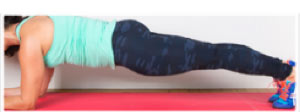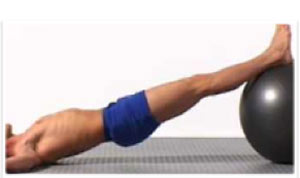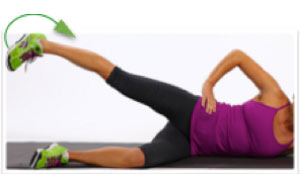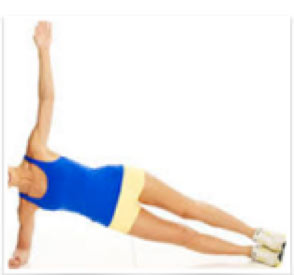Missing link in low back disorders
 Diagnosis of a low back disorder (LBD) often depends on who makes the diagnosis. Each diagnostician attempts to identify a primary dysfunction according to his/her particular favorable treatment. For example, a physical therapist and a surgeon diagnosing the same condition may take very different approaches toward a solution.
Diagnosis of a low back disorder (LBD) often depends on who makes the diagnosis. Each diagnostician attempts to identify a primary dysfunction according to his/her particular favorable treatment. For example, a physical therapist and a surgeon diagnosing the same condition may take very different approaches toward a solution.
Some clinicians, mostly surgeons, seek a specific tissue as a pain candidate, thus recommendations for nerve block procedures have shown conclusive pain source diagnosis in more than 50 percent of LBD cases. This has prompted research into which muscles or tissues are the best candidates as pain generators.
Biomechanists often argue that this search for a singular pain source may be irrelevant since a spine with altered biomechanics has altered tissue stress that can cause overload on another tissue, causing pain whether the damaged tissue is activated or not. This is referred to as “radicular pain,” radiculitis, or radiated pain due to inflammation or other irritation of the nerve root (radiculopathy) at its connection to the spinal column.
A common form of radiculitis is sciatica – radicular pain that radiates along the sciatic nerve from the lower spine to the lower back, gluteal muscles, back of the upper thigh, calf, and foot – secondary to nerve root irritation from a spinal disc herniation or from osteophytes in the lumbar region of the spine.
Most researchers in the field indicate a strong, stable core is important in avoiding LBD and for hastening recovery from LBD. For many, LBD actually results from an unstable core and back. Attempts at corrective LBD exercises have proven successful for many individuals, and effective rehab and prevention programs tend to start with activating the core muscles.
 Describing the core
Describing the core
The muscles of the core can be viewed as a serape frame, consisting of hip-to-shoulder muscle links. This frame includes the spine and dependent muscles connected to deeper core muscles that control diagonal rotational movement patterns of the hip and shoulders. It contains 29 pairs of muscles that balance and stabilize bones of the spine, pelvis, and lower extremities during movement.
The spine-frame becomes mechanically unstable without involvement of the core musculature, and most surely would collapse under the weight of the upper body. The core acts as an anatomical base for improving motion of the arms, torso, hips, and legs. Core stability is important in every gross motor activity, like walking, standing, and reaching.
The importance of a strong core
Top mountain climbers, off-road cyclists, tightrope walkers, various circus performers, surfers, and many other elite athletes already know the importance of a strong and stable core. They understand that performance, injury prevention, and overall movement success starts with a strong, stable, coordinated, and healthy “athletic core.”
This applies not only to elite athletes but to everyone.
Simple muscular development of the abdominals by doing sit-ups or other types of static abdominal exercises without corresponding muscular coordination and balance training is not sufficient to decrease injury potential, or optimize movement. Everyone can benefit from improving core strength.
Core anatomy
Core muscles include the abdominal muscles in front, paraspinals and gluteals in back, the diaphragm at the top, and the pelvic floor and hip-girdle muscles at the bottom.
Four major muscles comprise the abdominal core.
- The transversus abdominis is the deepest of the abdominal muscles. It is active during rotation and affects pelvic stability.
- The internal obliques compress abdomen organs and act in concert with the external obliques to flex and rotate the trunk. Both obliques are referred to as the trunk side rotators.
- The rectus abdominis muscle (commonly known as the “abs”) is a paired muscle running vertically on each side of the anterior wall of the abdomen.
- The rectus is a major trunk flexor and is important for rotation. It is a key postural muscle.
The diaphragm
The diaphragm is a dome-shaped muscle that separates the thorax from the abdomen.
Paraspinal lumbar extensor muscles
The major global extensor muscles of the lumbar region are the erector spinae, composed of the spinalis, longissimus, and iliocostalis muscles. The multifidi are deep short muscles primarily involved in segmental lower back stabilization rather than gross movements.
Pelvic floor, hip girdle, and gluteal muscles
 The pelvic floor muscles include the pubococcygeus, iliococcygeus, and ischiococcygeus muscles. These support the internal organs – bladder, intestines, and uterus.
The pelvic floor muscles include the pubococcygeus, iliococcygeus, and ischiococcygeus muscles. These support the internal organs – bladder, intestines, and uterus.
The psoas major muscle forms part of the back of the abdominal cavity and is part of the hip flexor. The psoas lifts the upper leg toward the body when the body is fixed, or pulls the body toward the leg when the leg is fixed.
The quadratus lumborum has two major components. The lateral and medial portions are powerful lateral trunk flexors, and elevate the pelvis or depress the thorax, depending on the relative flexibility of each component.
The gluteal muscles comprise the major “hip girdle musculature” and play a significant role within the kinetic chain, particularly for walking and running, stopping, stabilization of the trunk and pelvis, and in transferring force from the lower extremities to the pelvis and spine.
Warming up and activating the core
 The abdominal bracing technique is used to warm up and activate the core.
The abdominal bracing technique is used to warm up and activate the core.
Abdominal bracing involves simultaneously contracting the abdominal, lower back, and buttock muscles. When all these muscles work together all three layers of muscle in the abdominal wall are activated to protect and stabilize the spine and discs.
- Stand straight. Place one hand on the small of the back and one hand on the abdomen.
- Bend forward at the waist and feel the lower back (extensor) muscles contract.
- Come back to an upright posture and feel them “turn off.”
- Without bending forward, contract the abdominal muscles (like you are about the get punched in the stomach; feel them tighten with one hand) and the buttock muscles (as if you are holding in a bowel movement). You will feel the lower back muscles contract (with the other hand) when you contract your abs and buttocks.
- Another way to feel the brace is to try coughing or blowing out as if you were going to blow out a candle. You will feel the contraction in the abs, low back, and buttocks.
Starter core-strengthening program
Here are five core exercises that can be done anywhere at any time. These are great warm-up exercises and also will activate the core musculature.
Plank push-up
 Lie face down on the floor with feet together and forearms on the ground.
Lie face down on the floor with feet together and forearms on the ground.- Contract the abs and tighten the buttocks.
- Lift entire body off the ground until it forms a straight line from head to toe, resting on your forearms and toes. Try to avoid side-to-side hip movement.
- Slowly return the body to the ground, keeping the chin tucked and making sure the back remains straight.
- Hold position for 10 seconds; repeat 10 times.
- Lie on the left side with right leg on top of left.
- Rest on left forearm with elbow directly under shoulder.
- Pull up onto left forearm and left foot so that the feet, knees, hips, and shoulders form one straight line.
- Maintain position without dropping hips or torso, rolling pelvis backward, or bending at the waist.
- Hold for 10 seconds or until form breaks.
- Repeat steps 1-5 on the other side.
- Repeat 3-5 times on each side.
Challenge: Drop your hips a couple of inches, holding for 2 seconds, then press back to start. Control drop movement with pelvis, not shoulder.
 Sitting core rotation with ball
Sitting core rotation with ball
- Sit with your knees bent, legs together, and heels on the ground. Hold your arms straight out in front with both hands grasping a ball of any size. (See A at right.)
- Lean back slightly until you feel your abs contract. Maintain a normal lower back arch. Holding the ball, reach back and to the side, rotating your torso and head at same time. (See B at right.)
- Maintain wide reach while contracting abdominals to one side, and return to starting position. (See C at right.)
- Repeat 10 times on each side.
Plank on stability ball
 Lie down with legs straight and heels on top of a stability ball or chair.
Lie down with legs straight and heels on top of a stability ball or chair.- Press down on the ball/chair with heels as you squeeze your buttocks and lift the hips so the body forms a straight line.
- Slowly lower down to starting position.
- Repeat 10 times.
- The ability to use the large muscles in the legs and buttocks to extend the hips while maintaining proper balance is important for all types of movements.
Challenge:
1. Raise both arms over the chest as you lift your body off the ground. This will decrease the base of support and force activation of all stabilizing muscles.
2. Rise up using only one leg.
Side-lying external hip rotation
 Lie on your side with both legs straight. They should form a straight line from head to feet.
Lie on your side with both legs straight. They should form a straight line from head to feet.- Keeping your top leg straight, raise it into the air so it is even to, or higher than your top shoulder.
- Rotate at the hip joint and turn the top leg so your toes point toward the ceiling.
- Return to start position.
- Do 10 repetitions on each side.
- It is important that the lead leg create a stable base so the pelvis can rotate around it.
References
- Hodges, P.W. “Core stability exercise in chronic low back pain.” Orthopaedic Clinics of North America, 2003; 34:245.
- Katch, V. “The Lubopelvic System: Anatomy, Physiology, Motor Control, Instability and Description of a Unique Treatment Modality.” Chapter 17 in Donatelli, R.A., “Orthopaedic Therapy,” 4th Ed., 2010.
- Kliziene, I., et al. “Effects of core stability exercises on multifidus muscles in healthy women and women with chronic low-back pain.” Journal of Back and Musculoskeletal Rehabilitation, 2015; 28(4):841-7.
- Leonard, J.H., et al. “Changes in transversus abdominis muscle thickness after lumbo-pelvic core stabilization training among chronic low back pain individuals.” Clinical Therapeutics, 2015; 166(5):1884.
- McGill, S. “Low back disorders: Evidence-based prevention and rehabilitation.” Human Kinetics, 2nd Ed., 2007.
- Richardson, C., et al. “Therapeutic exercise for spinal segmental stabilization in low back pain.” Edinburgh, Scotland: Churchill Livingstone, 1999.





Julie Singer - 1990
Thank you for the article. It is very informative. I will incorporate the core practice in my own workout & share it with my family, friends & yoga students. Namaste
Reply
Lea Hapner Grossman - 1996
I really enjoy reading your monthly informative emails… having moved away, it warms my heart. Thank you 🙂
The section about strengthening our core speaks right to my ‘back’. Being an older U of M alumni with the dreaded arthritis in practiclly every joint, which more gentle exercises would your professionals recommend, please?
ALSO, just as important, I tend to have a poor diet. I know what I should be eating to stay healthy, but yet I do not seem to be able to keep to it…. I live alone, I don’t eat out much, and I do not but prepared foods…..however, chocolate, and quick ‘fixes’ such as yogurt, tuna from the can etc, is much easier to prepare for a person living alone.
I’d be very happy to get your input. ThAnks ever so much in advance. 617.277.1512 Lea
Reply
Julie West
Try yoga. Great for the core. We go to yoga shelter. Matt us our favorite instructor.
Reply
Russell Lyons - 1983
The instructions for the side-lying external hip rotation begin, “Lie on your side with both legs straight. They should form a straight line from head to feet.”
However, the picture shows that the bottom leg is bent. Furthermore, the instructions state, “It is important that the lead leg create a stable base”. I guess that “lead” refers to the bottom.
I recommend clarifying all this.
Reply